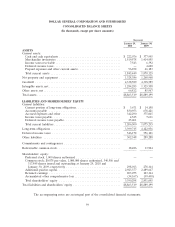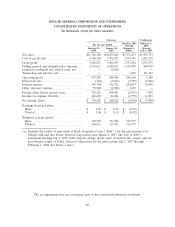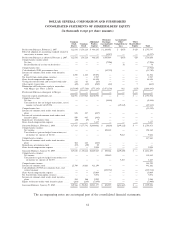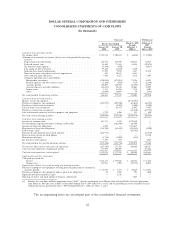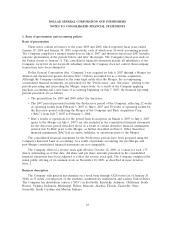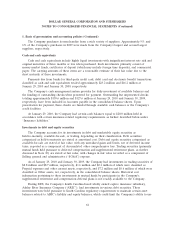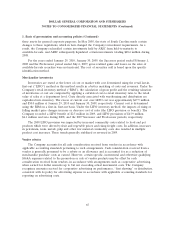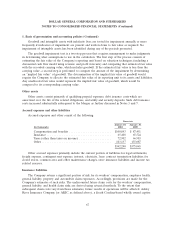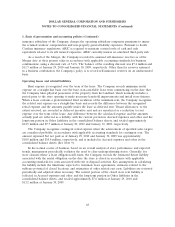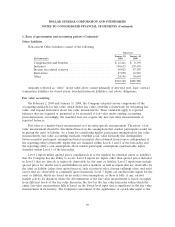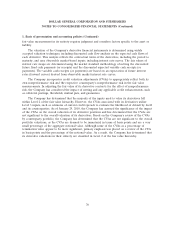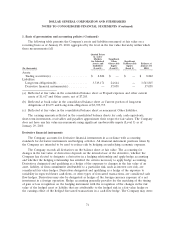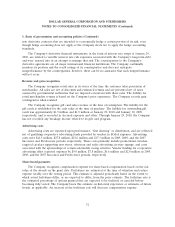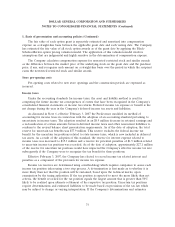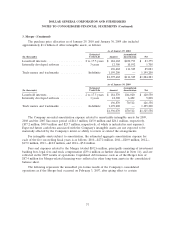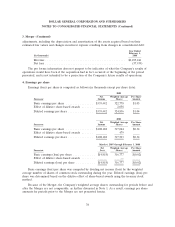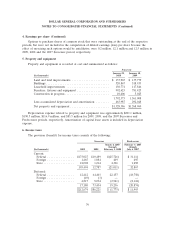Dollar General 2009 Annual Report Download - page 80
Download and view the complete annual report
Please find page 80 of the 2009 Dollar General annual report below. You can navigate through the pages in the report by either clicking on the pages listed below, or by using the keyword search tool below to find specific information within the annual report.
DOLLAR GENERAL CORPORATION AND SUBSIDIARIES
NOTES TO CONSOLIDATED FINANCIAL STATEMENTS (Continued)
1. Basis of presentation and accounting policies (Continued)
Other liabilities
Non-current Other liabilities consist of the following:
Successor
January 29, January 30,
(In thousands) 2010 2009
Compensation and benefits ......................... $ 12,441 $ 8,399
Insurance ...................................... 140,633 139,410
Income tax related reserves ......................... 68,021 47,307
Derivatives ..................................... 57,058 63,523
Other ......................................... 24,195 30,649
$302,348 $289,288
Amounts reflected as ‘‘other’’ in the table above consist primarily of deferred rent, lease contract
termination liabilities for closed stores, leasehold interests liabilities, and rebate obligations.
Fair value accounting
On February 2, 2008 and January 31, 2009, the Company adopted various components of the
accounting standards for fair value, which define fair value, establish a framework for measuring fair
value, and expand disclosures about fair value measurements. These standards apply to reported
balances that are required or permitted to be measured at fair value under existing accounting
pronouncements; accordingly, the standard does not require any new fair value measurements of
reported balances.
Fair value is a market-based measurement, not an entity-specific measurement. Therefore, a fair
value measurement should be determined based on the assumptions that market participants would use
in pricing the asset or liability. As a basis for considering market participant assumptions in fair value
measurements, fair value accounting standards establish a fair value hierarchy that distinguishes
between market participant assumptions based on market data obtained from sources independent of
the reporting entity (observable inputs that are classified within Levels 1 and 2 of the hierarchy) and
the reporting entity’s own assumptions about market participant assumptions (unobservable inputs
classified within Level 3 of the hierarchy).
Level 1 inputs utilize quoted prices (unadjusted) in active markets for identical assets or liabilities
that the Company has the ability to access. Level 2 inputs are inputs other than quoted prices included
in Level 1 that are directly or indirectly observable for the asset or liability. Level 2 inputs may include
quoted prices for similar assets and liabilities in active markets, as well as inputs that are observable for
the asset or liability (other than quoted prices), such as interest rates, foreign exchange rates, and yield
curves that are observable at commonly quoted intervals. Level 3 inputs are unobservable inputs for the
asset or liability, which are based on an entity’s own assumptions, as there is little, if any, related
market activity. In instances where the determination of the fair value measurement is based on inputs
from different levels of the fair value hierarchy, the level in the fair value hierarchy within which the
entire fair value measurement falls is based on the lowest level input that is significant to the fair value
measurement in its entirety. The Company’s assessment of the significance of a particular input to the
69


